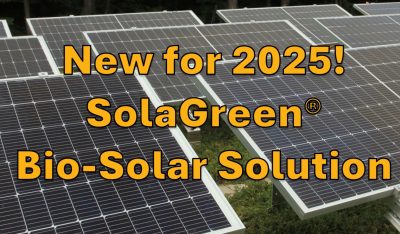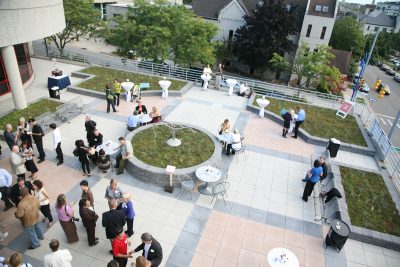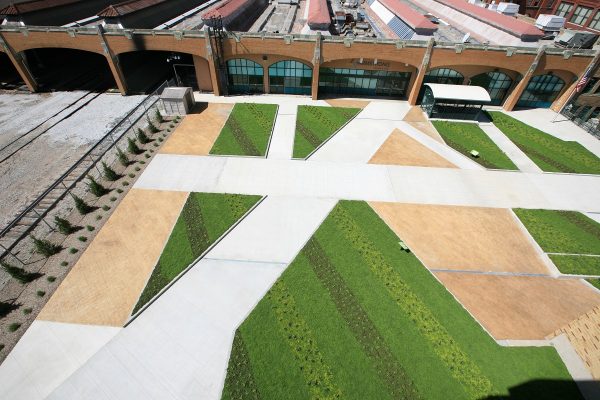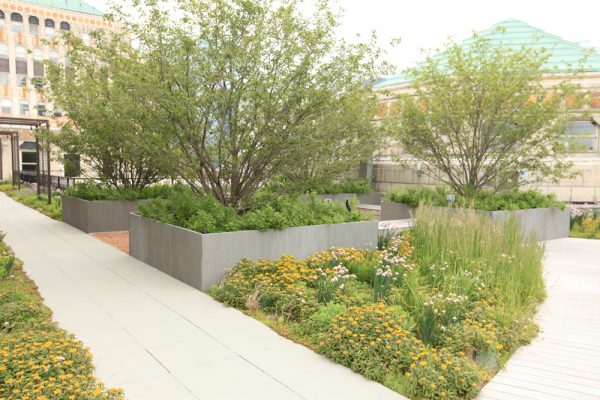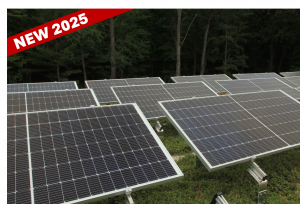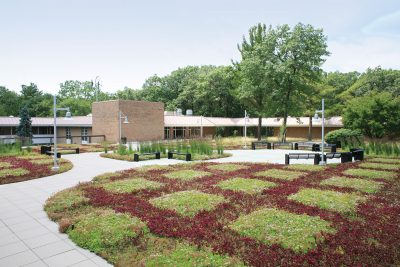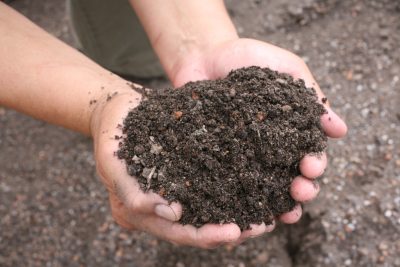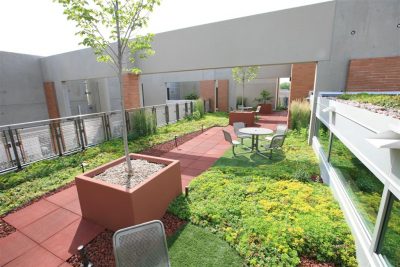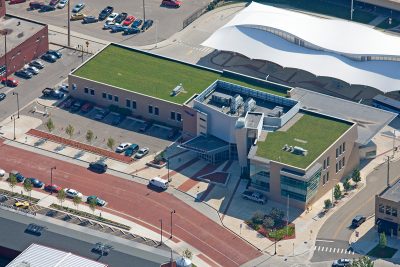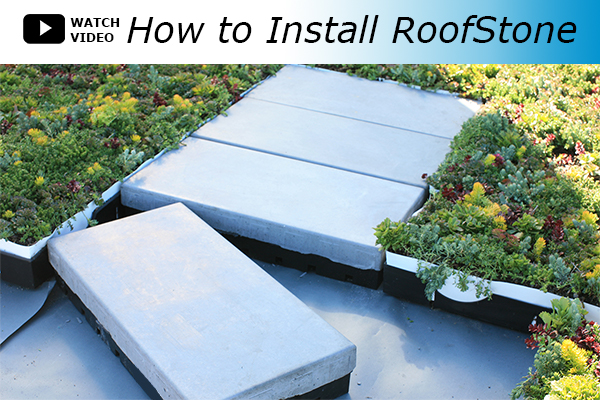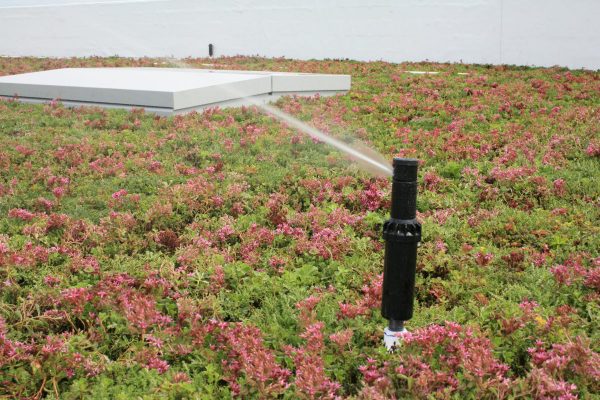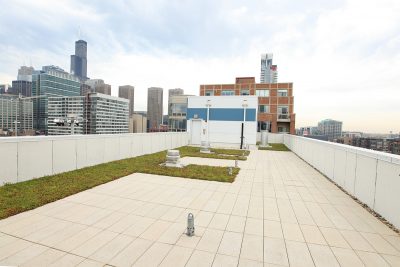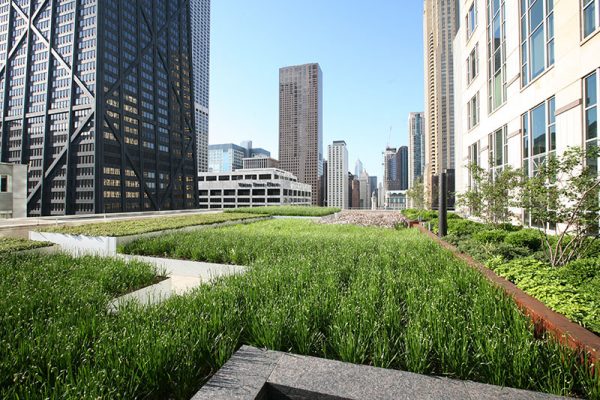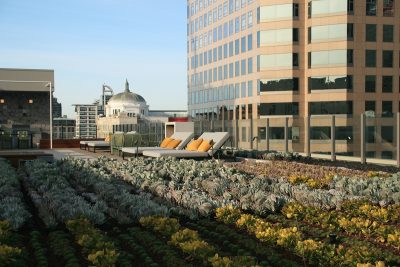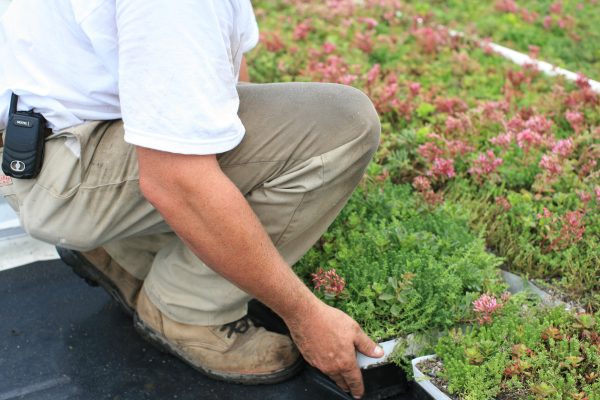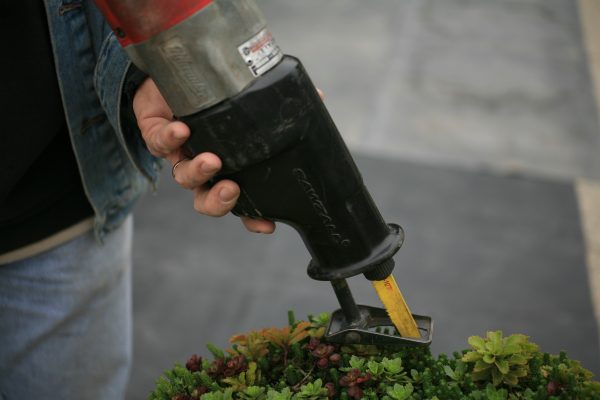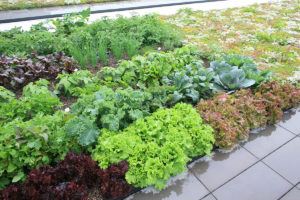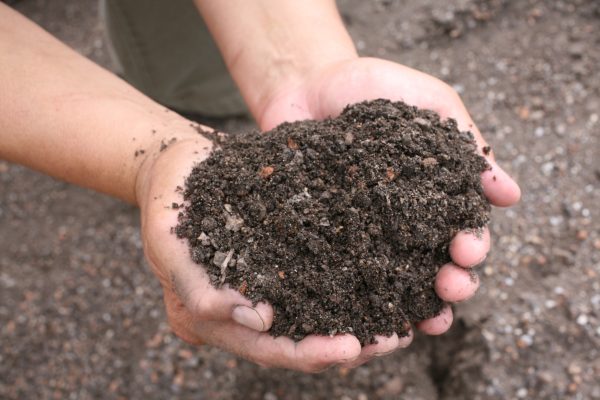BENEFITS
Yes! World-renowned green roof researcher, Brad Rowe, published a study in 2022 that compares the stormwater retention effectiveness of several green roof, blue roof, and blue-green roof systems & methods.
Additional research by Dr. Anna Droz tests RoofBlue RETAIN™ ‘s effects on plant growth and irrigation needs. Results show significant water savings and increased plant growth in the RETAIN™ modules.
Extension of the lifetime of the roof; typical estimates are that a green roof potentially extends the lifetime of a roof between 200 and 300 percent, by protecting the rooftop from ultraviolet radiation, large temperature fluctuations, drying winds, and punctures.
Not only does the roof last longer, but there is reduced membrane maintenance. All this brings about significant cost savings over time. In some communities, storm water incentives may also bring substantial monetary benefits.
As the huge costs associated with stormwater runoff are becoming recognized and as smog and other pollution impacts our cities, many cities and states are encouraging “green” building methods, including green roof systems. By offering financial incentives for green roofs, municipalities help to reduce storm water surges, and therefore protect the ground water, lakes and streams, and encourage energy conservation.
Of course, incentives vary from city to city and state to state, but it is not uncommon for owners of buildings with green roofs to be generously rewarded. The city of Portland, OR, provides financial, technical and educational incentives to participants through its green roof initiative. Washington, Illinois, New York, Montreal, California and Maryland have also implemented incentive structures. Cities all across North America are following suit, and grant money is often available for the energy conservation and air and water quality benefits that green roofs bring. Be sure to check with your state and local governments. Don’t assume that nothing is available. States and municipalities benefit greatly from green roofs, and often provide tax credits, avoidance of fees assessed for impervious surfaces, grant funding, and/or favorable zoning to encourage their use.
Visit GreenRoofs.org for a list of some incentives, policies, and resources for green infrastructure.
Green roofs have been proven to bring about significant energy savings, particularly during the summer cooling season in which single story buildings can experience a reduction of greater than 25% energy use for air conditioning. Green roof soils insulate the roof from heat, and green roof plants transform heat and soil moisture into humidity, to create natural evaporative cooling. Each gallon of water transpired by the plants or evaporated from the soil surface liberates 8000 BTU of thermal energy.
In urban areas, impermeable surfaces (streets, sidewalks, rooftops etc.) dominate the landscape, preventing rainwater from following a natural cycle of absorption. Instead, as much as 75% of the rainwater runs into sewer systems carrying contaminates from the air and roadways (salt, oil, mercury, etc.). This water flows untreated into lakes and streams. In some cases, it may cause overflows of sanitary sewer systems, causing the dumping of untreated sewage (combined sewer overflow).
In contrast, LiveRoof green roof surfaces can absorb a substantial amount of rainfall reduce runoff, lessen the risk of combined sewer overflows and flooding, and to some degree filter the water as it percolates through the LiveRoof soil. Even when a rainfall is such that it can not all be absorbed by your LiveRoof, the excess rain that runs through the growing medium is filtered and delayed until after peak flows, which allows additional time for sanitary sewer systems to handle uncontrolled runoff.
In urban areas, impermeable surfaces (streets, sidewalks, rooftops etc.) dominate the landscape, preventing rainwater from following a natural cycle of absorption. Instead, as much as 75% of the rainwater runs into sewer systems. Carrying contaminates from the air and roadways (salt, oil, mercury, etc.), this water flows untreated into lakes and streams. Older large cities often employ combined sewer systems, which can lead to untreated sewage release directly into local waterways during heavy downpours. The detrimental effect of excess sewage release into local waterways often results in lowered property values, high cleanup costs or even hefty federal government fines to be borne by the local community.
In contrast, LiveRoof® green roof surfaces can absorb significant rainfall, lessen the risk of flooding, and to some degree filter the water as it percolates through the soil and as the plants take up certain heavy metals and nutrients. Even when a rainfall is such that it can not all be absorbed by your green roof, the excess rain that runs through the media is filtered and delayed until after peak flows. Because green roofs soak up much of the initial rain water during a storm, the municipal system has additional time to better manage the stormwater and reducing the likelihood of a combined sewage overflow (CSO).
Additional detention is possible when a blue roof system is used in combination with green roof. LiveRoof modules elevated with RoofBlue risers on rooftops with control-flow drains may reduce the size of drains, need for cisterns or underground storage tanks, and the costs of stormwater utilities.
Simply put, it is the temperature difference that exists between urban areas and their surroundings. Urban areas tend to be from 7 to 10 degrees hotter due to the concentration of heat-absorbing buildings, pavement, auto-exhaust, and hot air from cooling systems. The bubble of hot air that encloses cities is in large part due to lack of vegetation and is a great contributor to smog, ozone and dust (from artificially created air currents from the rising hot air). The urban heat island effect has also been shown to create unique weather patterns, with inordinate drought, high winds and electrical storms being more common than surrounding rural areas.
Traditional rooftops are usually covered with tar, black membrane, shingles or stone. As a result, they absorb sunlight. On sunny days with an air temperature of 95°F, city roofs can easily reach temperatures of 175°F or more. The LiveRoof® system acts like a protective umbrella above the roof to shade and insulate buildings, avoiding the heat island effect associated with traditional rooftops.
Plants, of course, release oxygen and evaporate water, and the soil they live in evaporates water. Collectively, these processes are known as evapotranspiration and act like evaporative cooling systems to make the surrounding air considerably cooler. By implementing a LiveRoof® system, the combined benefit of eliminating the heat generated by a non-vegetated rooftop, along with the evaporative cooling effect, is significant.
DESIGN
LiveRoof systems are compatible with nearly all waterproofing types: EPDM, TPO, PVC, bituminous, polyurethan, rubberized asphalt, inverted or conventional. Some green roof system providers form alliances to leverage sales. We don’t believe in playing such games as our goal is to provide the best quality green roofs on the market and make them available to all. In keeping with these ideals, we make LiveRoof available for pairing with all appropriate waterproofing products (from all manufacturers). We can suggest typical waterproofing build-ups, and in every case the manufacture’s “approved LiveRoof-compatible build up” should be specified and followed.
Pavers may need to be cut to fit at the perimeter or around rooftop penetrations and equipment. For the cleanest cuts, LiveRoof recommends a wet saw with a 14” diamond concrete blade. A piece of tape should be placed over the cut line to prevent chipping. Most chop saws or circular saws will require cuts to be made on both sides of each paver.
Cut the concrete top first, then flip the paver over and finish the cut through the plastic base. Curved cuts can be made by making several straight cuts on an angle to create the curve.
To accommodate ridges, low penetrations, or irrigation lines, notches may be cut out of the plastic base. An angle grinder with a blade suited to cutting plastic is best for this task. It is ideal to remove entire sections of the RoofStone base when making notches. This keeps the factory edges in contact with the roof membrane and prevents potential damage from burs.
The best irrigation method is the one that most efficiently applies the water and provides the lowest lifecycle cost. In the case of green roof applications, this choice is straightforward and simple. Spray rotor systems are the least expensive to install, easiest to maintain, and apply water most efficiently. This may run counter to what is sometimes spoken about spray vs. drip or sub-irrigation, but it’s the truth and has been born out by testing at LiveRoof, LLC and research at Michigan State University.

Closeup views of drip and sub-irrigation emitters and layout of overhead irrigation system showing four of six emitters.
To understand why spray irrigation uses less water than drip or sub-irrigation systems on green roofs, one must realize that green roof soils are engineered to maintain their volume and last the life of the building, and therefore are different in composition and characteristics than nursery or natural field soils. Nursery and natural field soils are typically high in organic content. But, green roof soils are very low in organic content, to avoid volume loss via decomposition of the organic matter. In nursery and natural field soils, drip or sub-irrigation systems can often conserve water, because these types of soil are good at dispersing water laterally or wicking it upward by capillary action – through the absorbent and capillary qualities of the soil. But green roof soils, which are predominantly composed of inorganic aggregates, have poor capillary qualities and do not conduct water effectively in either a lateral or vertical manner. To irrigate them with drip irrigation, one must set the tubes so closely together that the cost is prohibitive. And, to irrigate them with sub-irrigation, one will use more water than spray irrigation and may risk root rotting diseases, from too much water saturation to the lower level roots.

Representative horizontal movement of wetting front for Live Roof substrate subjected to drip irrigation after 5, 15, and 25 min.

Representative horizontal movement of wetting front for Live Roof substrate subjected to sub-irrigation after 10, 20, and 30 min. Orange flags show location ofsub-surface emitters.
A well-designed overhead spray irrigation system, very much like what would be used in a home or commercial landscape, provides even coverage to the surface of plants and soil at a very low installation cost. Such systems are simple and inexpensive to maintain, and apply the water quickly and efficiently. Studies by Dr. Bradley Rowe, PhD, and others at Michigan State University Department of Horticulture compare the effectiveness of drip, sub, and overhead spray irrigation methods, and the researchers found that drip and sub-irrigation systems wasted more than double the water lost in an overhead spray irrigation system.

Plant growth of Sedum album and Sedum floriferum subjected to overhead, drip, sub, and no irrigation following 12 weeks.
Images courtesy of: D.B. Rowe et al. / Ecological Engineering 64 (2014) 306– 313
Retention means that a specific volume of water is retained on the roof for an indefinite period of time. Detention means to temporarily detain stormwater before discharging it as runoff.
RoofBlue DETAIN is intended for use as part of a water detention system, whose main function is to delay and control the flow of stormwater runoff. This delay allows more time for municipalities to treat runoff, which helps to prevent stormwater and combined sewage systems from overflowing (untreated) into local waterways.
RoofBlue RETAIN is LiveRoof’s patented solution for stormwater retention. It captures and retains stormwater, following a storm event, transferring water upward towards the plant roots as the soil dries out, to keep soil appropriately moist and plants healthy. This can result in enhanced plant growth, lower irrigation needs, and increased stormwater management on your green roof.
A blue roof is designed to slow or store stormwater runoff, easing the burden on the stormwater systems. When combined with the LiveRoof® brand green roof system—which in itself is an effective stormwater tool—the RoofBlue system maximizes rooftop stormwater management capability. This may greatly reduce the need for other onsite stormwater management tools, such as cisterns, detention ponds, or underground storage tanks.
Control flow drains are designed to slow the rate of runoff from roofs during storm events. These drains typically have an insert with a weir that regulates the flow of water through the drain. They are available in a variety of heights. Generally, flat roofs have lower weir heights than sloped roofs. Some models have adjustable weirs which can be set for each drain / location, and some may utilize copper flanges to inhibit root growth. All control flow drain systems should be carefully designed by a licensed professional engineer. These manufacturers sell controlled flow drains:
Most membrane manufacturers will have special requirements for blue roof applications. In the early stages of blue roof design, is absolutely critical for engineers and specifiers to work with membrane manufacturers to select appropriate materials, thicknesses and to provide assembly instructions according to local code.
Also, confirm that the waterproofing specification complies with code. Some municipalities have specific requirements for blue roof applications. (Example: New York City stormwater construction guidelines address blue roofs).
RoofBlue DETAIN applications should be designed to hold no more than 3.5” of water beneath the green roof system.
Each inch of water weighs approximately 5.2 pounds per square foot, so at maximum water detention, the blue roof solution would add up to 18.2 pounds per square foot of load to the weight of the green roof modules (find saturated weights here).
The maximum saturated weight of the RoofBlue RETAIN system depends on the LiveRoof modules used:
- <= 29.5 lbs/ft2 for Lite modules
- <= 41.5 lbs/ft2 for Standard modules
- <= 62.5 lbs/ft2 for Deep modules, and
- <= 77.5 lbs/ft2 for Maxx modules
Certainly—median strips, patios, plazas, and malls can be instantly landscaped with fully mature ground covers using LiveRoof modules.
%20copy-600x400.jpg)
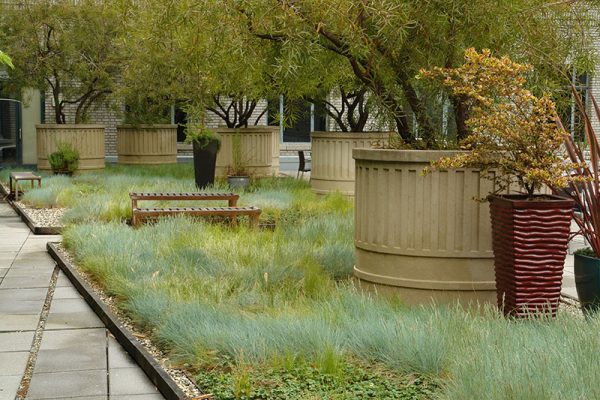
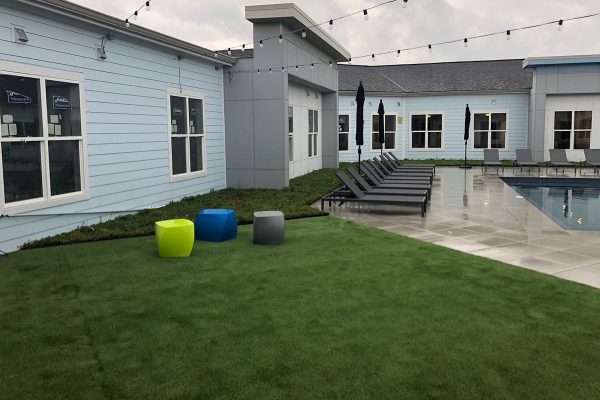
The need for irrigation (beyond normal rainfall) will depend upon the plants selected, the local climate, and specific weather patterns, roof slope, and which LiveRoof system is selected. In the north temperate zone (Standard system), supplemental irrigation may seldom be required. Even so, we suggest a backup irrigation system in the event of prolonged hot, dry, windy, sunny weather. During long bouts of dry weather, plants can shrink up, desiccate, die and expose soil. This can increase maintenance requirements as weeds can become established in bare soil and supplemental planting may be required. Excessively dry soil also causes the evaporative cooling effect of the green roof to stop.
Irrigating, even once per month during protracted dry weather, can keep your green roof looking its best and pay dividends through maintenance reductions and evaporative cooling. How frequently one must irrigate during protracted hot, dry weather will vary plant material, climate, exposure, wind, temperature, humidity and roof slope. Installing an appropriate irrigation system brings the peace of mind that when irrigation is needed, it can be applied quickly and conveniently.
Note: In areas of predictably hot and dry spring, summer and fall weather, one should always incorporate an irrigation system into the design. But, irrigation should not be used excessively – please consult your local LiveRoof grower for specifics.
RoofStone follows the roof contour and can be used to create walkways, patios, and landing areas on most non-ADA compliant roofs.
RoofStone can also be used on roofs that must be ADA-compliant with slope up to 1:48, which equals 2.08% or 1.19 degrees. This is ¼ inch per 1 foot, which is the norm (minimum) roof slope for drainage.
In our experience, most roofing assemblies recommend that water does not stand for longer than 24 hours.
However, we recommend that architects and engineers confirm the maximum amount of time allowable for detention with the membrane manufacturer before specifying the type, size and placement of drains and pipes.
LiveRoof’s project showcase contains volunteered projects from across North America. Submit your project today using our simple online form. Submit high resolution photos to sales@liveroof.com and/or call 800-875-1392, and you may see your project featured in our next design guide printing.
The LiveRoof® system weighs approximately 27-29lbs./sq. ft. (with a media depth of 4”) when fully vegetated and saturated. The LiveRoof® soil follows FLL standards, enhanced to reflect current research regarding sustainable organic content. We have intentionally avoided excessive organic content, which will shrink excessively over time due to decomposition. Likewise, we have avoided perlite which may break down during the freeze thaw cycle.
Yes, normally this is done on rooftop patios where the load limits do not allow for the weight of 2 or 3 feet of soil in the planters. In this case, all but the top 4-1/2 to 6-1/2 inches of the planter is filled with closed cell foam, then LiveRoof is set on top to give the illusion of substantial soil volume.
Read more about lightweight green roof implementation on our blog post.
A green roof can wholly transform a space! The ability to retrofit for a green roof depends upon the structure’s ability to bear the additional weight load. A qualified structural engineer should ALWAYS be consulted to determine safety prior to installation of LiveRoof modules or RoofStone pavers.
The LiveRoof Lite system was developed to expand the opportunities for green roofs on existing buildings. With 2.5″ of soil, the system’s saturated weight is 15-17 lbs / sq ft.
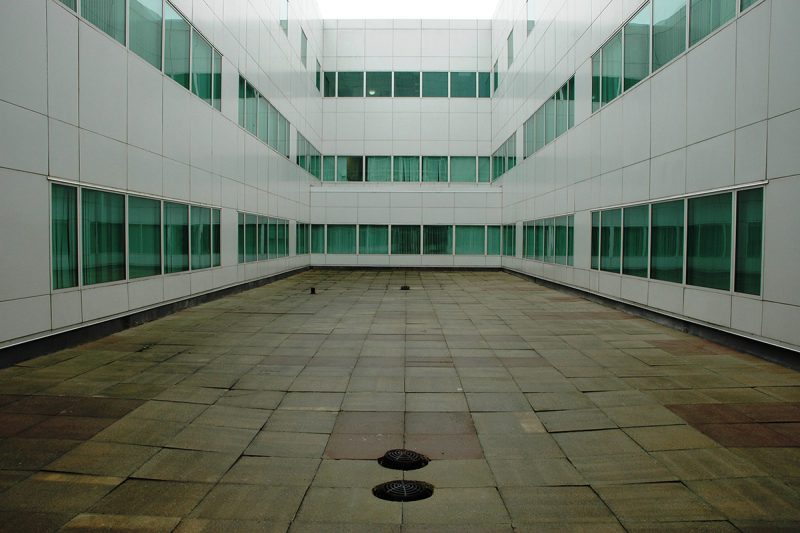
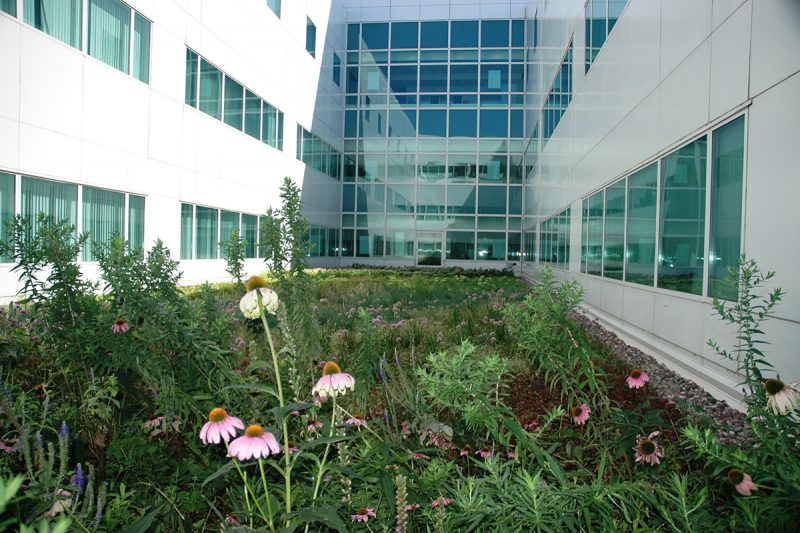
INSTALLATION
Contact your LiveRoof local grower. See our grower network or call LiveRoof at 1-800-875-1392 or by email at sales@LiveRoof.com.
Professional landscape and roofing contractors interested in offering LiveRoof installation services should contact their local representative for more information about opportunities to join our Certified Installer network.
We have developed an online training program for contractors working on their first LiveRoof project. The course covers product, installation and initial maintenance specifications to equip estimators in preparing bids. Prior to the first project installation, LiveRoof representatives conduct in-person training with the job site foreman and installation team.
Yes, LiveRoof® modules can be cut to size and shape with the use of a masonry saw or reciprocating saw. When custom cutting LiveRoof® modules, the cut side should abut the non-cut side of another module, in order to contain the soil and minimize the work of installation.
If the cut side ever abuts edging, it should not be edging that is located on the low, draining side of the roof. Always fit modules tightly against edging or parapet or surround with drainage fabric for added security.
MAINTENANCE
Every automatic sprinkler system is different, so it is important to take the time to measure your system’s output. With a ruler, some basic math skills, and a few shallow cans (such as tuna cans) or rain gauges, one can easily figure out how long to run their sprinklers for effective green roof irrigation. We have outlined one simple process below and included some links for further reading.
Step 1: Gauge Placement
Using at least three rain gauges or tuna cans, place them in a line leading out from the sprinkler. One should be close to the sprinkler, one in the middle of the range, and one near the outer edge of the range.
Step 2: Measuring
After your gauges are placed, turn on your sprinklers, and let them run for 15 minutes. Turn them back off, and use a ruler to measure the depth of water collected in your gauges. If there is 1/4 inch of water, and you are aiming for one inch, you know that you must run your sprinklers for one hour.
Adjust according to your green roof’s needs and recommendations from your LiveRoof representative.
Additional resources:
The life cycle of most weeds is about four weeks. Therefore, by weeding every 2 weeks, for just a few minutes, the few weeds that come from birds and the wind are not allowed to reproduce (and become many). This is the “smart” way to manage a LiveRoof, and it is what allows one to have a pristine LiveRoof with almost negligible maintenance costs.
Minimally and sparingly. One person can do this a couple times a week without causing permanent harm. However, you must avoid walking in a single path, standing in one place, or trampling your plants.
If you must service a wall, parapet, or rooftop equipment, wait until the foliage is dry and conditions are not too sunny or hot. Then, cover the plants with plywood or closed-cell foam for up to 4 hours.
Avoid repetitive foot traffic when plants are wet or frozen.
Whenever possible, avoid installing the green roof until all other trades have completed work on the skylights, parapets, HVAC or other rooftop equipment. In our experience, the most common cause of plant losses are foot traffic from other trades performing work to equipment adjacent to the green roofs.
The need for irrigation (beyond normal rainfall) will depend upon the plants selected, the local climate, and specific weather patterns, roof slope, and which LiveRoof system is selected. In the north temperate zone (Standard system), supplemental irrigation may seldom be required. Even so, we suggest a backup irrigation system in the event of prolonged hot, dry, windy, sunny weather. During long bouts of dry weather, plants can shrink up, desiccate, die and expose soil. This can increase maintenance requirements as weeds can become established in bare soil and supplemental planting may be required. Excessively dry soil also causes the evaporative cooling effect of the green roof to stop.
Irrigating, even once per month during protracted dry weather, can keep your green roof looking its best and pay dividends through maintenance reductions and evaporative cooling. How frequently one must irrigate during protracted hot, dry weather will vary plant material, climate, exposure, wind, temperature, humidity and roof slope. Installing an appropriate irrigation system brings the peace of mind that when irrigation is needed, it can be applied quickly and conveniently.
Note: In areas of predictably hot and dry spring, summer and fall weather, one should always incorporate an irrigation system into the design. But, irrigation should not be used excessively – please consult your local LiveRoof grower for specifics.
Yes, but likely not every year. The need to apply fertilizer will depend upon a number of factors, including plant type, climate, weather patterns, irrigation water, and more. Thus, LiveRoof recommends that each spring, before spring growth flush, a sample of green roof soil is sent in for testing to a lab qualified to test green roof soils (as compared to a typical field soil test).
If the Nitrogen (N) levels are low, the green roof will benefit from an application of controlled release fertilizer:
If Phosphorus (P) tests are low and the municipality allows for a fertilizer containing Phosphorus – we recommend Lesco 14-14-14. The application rate can vary based on need, and typically ranges from 1.5 to 3.0 pounds of actual Nitrogen (N) per 1000 square feet which is appx. 10 to 20 points of actual fertilizer per 1000 square feet. It comes in 40 pound bags, so a bag would cover 2000 to 4000 square feet of green roof.
If P tests are low and the municipality does not allow P in the fertilizer – we recommend Lesco 21-0-21. The application rate is typically 1.5 to 3.0 pounds of actual N per 1000 square feet, but in this case calculates to 7 to 14 pounds of actual fertilizer per 1000 square feet. It comes in 50 pound bags, so a bag would cover 3500 to 7000 square feet of green roof.
No, LiveRoof plants are damaged by de-icing chemicals. If your LiveRoof is adjoined by pedestrian walkways, you should use sand or cat-litter as an anti-slip measure after shoveling.
It is relatively easy to remove a LiveRoof module to access the roof deck.
- First, using a flat bladed shovel, probe the planting to locate the container edge.
- Then peel away some plant material. This is easy to do as the root systems of LiveRoof® plants is fibrous and easy to separate (not at all like sod).
- Using a sturdy pair of pliers, lift up and remove the exposed module.
- Any additional modules may be removed by trimming around them with the handle of a spoon and lifting them up.
- Once you are finished, replace the modules.
Important: Never use sharp instruments around roof membranes.
Dog urine and excrement are toxic to (and will kill) succulent green roof plants. Therefore, unless you have a green roof that is specifically developed for dog traffic, dogs should be kept off of the green roof.
If your green roof has been specifically developed for dog traffic, then it is likely vegetated with either a turf grass or a lily-turf, such as Liriope NoMo® or Liriope spicata. Such roofs require a minimum of 6 inches of soil (the LiveRoof deep system), and should be cared for so as to preserve the plants material. Excrement should be picked up and the plants should be watered regularly, not just for hydration, but to flush the urine from the soil.
PLANTS & SOIL
In the Lite and Standard systems, we only recommend plants which have extreme drought resistance through some means other than the root system. This means succulent, water-holding plants like Sedums, Alliums, Sempervivums, and Delospermas in the northern temperate regions, and similar species farther south.
The best LiveRoof plants will both store water and have a special type of metabolism called ‘Crassulacean Acid Metabolism’ (CAM). CAM plants are unique in that under drought conditions their stomates (leaf pores) are open at night rather than during the day, as is the case with most plants. CAM plants exchange gasses (oxygen and carbon dioxide) in the dark when it is cooler and less windy. CAM plants are up to ten times more efficient with water conservation than non-CAM plants.
In the Deep and Maxx systems, with irrigation, a broader plant palette is possible.
In all cases, consult with your local LiveRoof licensed representative for recommendations of the best plants for the climate.
Numerous vegetables, herbs, and select fruits (such as strawberries and melons) may be grown on intensive green roofs that receive frequent watering, have ample sunlight, and have proper soil.
Edible plants require sufficient nutrients to support their rapid growth cycle and the energy needed to bear fruit.
When growing produce on green roofs, a blend of organic soil and traditional green roof growing media yields the best results; however, the soil will need annual amendments to maintain volume and provide sufficient nutrition.
LiveRoof® brand engineered green soil is composed of approximately 94% high quality inorganic aggregates (by dry weight), contains a special clay particle to bind nutrients (in most regions), contains an acid rain buffering component (where appropriate), and is formulated with disease-suppressive organic material at a level that is consistent with ecologically sustainable soil/plant communities.
Our soil is designed to last indefinitely and to not substantially shrink over time. Cheap mixes with high levels of peat and compost will decompose and wash away as humic acid.
LiveRoof soils are formulated regionally by approved blenders. These local adaptations of LiveRoof engineered soil will vary somewhat in composition based upon climate, water quality, and regionally available components.
Filter cloth, like any filter, is designed to filter. Over time, filters may plug up—think of your car’s air and oil filters, your furnace filter, coffee filter, etc. If green roof filter plugs up, then what?
Because of the aggregate nature of engineered soil, very little escapes through the LiveRoof module’s drain holes. It’s like trying to push marbles through a funnel or a square peg through a round hold. In addition to this simple act of geometry, the roots of the plants bind the soil together and hold it in place.
PRODUCT FEATURES
With its unique patent pending Soil Elevators® and Moisture Portals™, the LiveRoof® system gives you the look and function of a conventional green roof “membrane” system, with the turn-key benefits of a modular system. LiveRoof represents the best aspects of modular and conventional green roofs combined in one simple, attractive effective system.
As growers, we designed the system in conjunction with experts in the fields of architecture, roofing, logistics, and ergonomics. Our system is designed to grow healthy plants!
- Because our modules are fully matured at the nursery, they require minimal maintenance.
- For each project, we develop and supply a customized operation manual based on the climate, size and plant type. Anyone with very basic understanding of plants can care for their LiveRoof as long as they follow the simple care protocol. You don’t need to be a horticulturalist to realize a healthy green roof.
- LiveRoof modules are populated with plants customized for each projects’ microclimate and design objectives.
- If there is ever any need to make changes to the roof, LiveRoof modules allow simple access to the roof without needing to cut through plastic drainage and filtering layers.
- LiveRoof modules are molded in the US from recycled plastics.
The cost of any green roof is the sum of four costs: acquisition, maturation, maintenance and lifecycle. If one fixates on low aquisition cost, they are likely to get stuck paying for high maturation expenses, high ongoing maintenance costs (ongoing headaches) and a high lifecycle cost (with a system that is short lived). With LiveRoof, that is not the case—we deliver quality, beauty and long term value.
LiveRoof is a value system. It is not typically the “cheapest” system to acquire (nor is it the most expensive). Compared to other options, it will likely cost a great deal less over time. Here is why LiveRoof is the best value:
Horticultural experts avoid standing water. That’s because standing water is deprived of oxygen, and roots sitting in oxygen-deprived water become diseased with fungal and bacterial rot. This weakens the plant, and may perpetually handicap the plant and predispose it to secondary disease and insect infestation.
After considering pros and cons of powder coating versus anodizing, we chose to anodize RoofEdge. Powder-coated finishes offer flexibility in color options; however, the durability of the finish can vary greatly. With some products, we observed loss of paint in as little as two years.
As green roofs are intended to last decades, we need a finish that would last as long. As anodization is a change to the chemical composition of the aluminum component’s surface, it becomes a permanent feature. This finish is most suitable for salty environments (such as near ocean spray) and its hardness allows the finish to endure more abuse than a coated product.
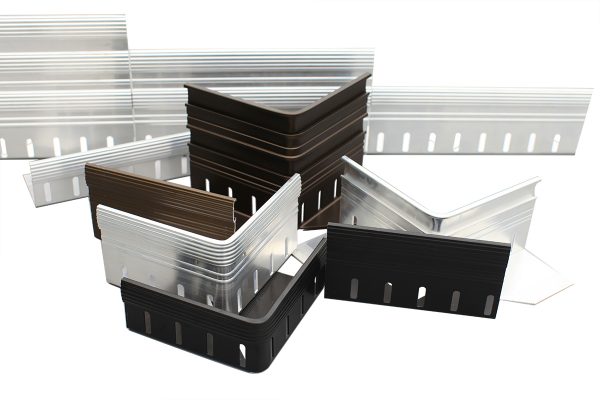
- RoofBlue DETAIN raises the modules an additional 3.5” from the roof surface. The void space inside the RoofBlue DETAIN module is approximately 90.5%.
- At 3.5”maximum water depth, RoofBlue DETAIN provides up to 455 cubic inches (approximately 2 gallons or 7.4 litres) of water detention per square foot.
- The control flow roof drain insert should be even to the lowest point of the green roof installation, the water will not exceed 3.5” in height. This ensures that the plant roots are kept out of standing water.
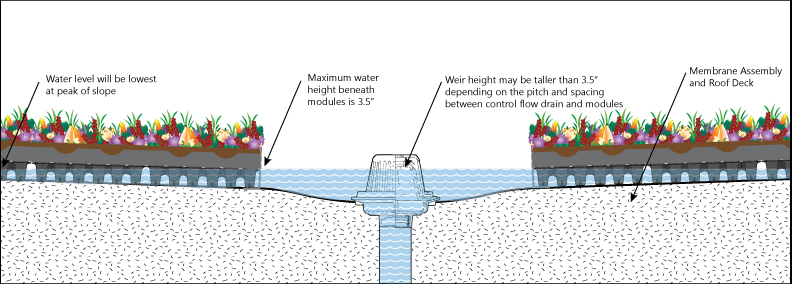
RoofBlue is compatible with all LiveRoof module sizes. RoofBlue DETAIN will raise the green roof system by an additional 3.5”, which means that taller aluminum edge restraints are required to surround the entire blue green roof assembly.
Edging Recommendations
SolaGreen
Bio-Solar roofs save on energy in two ways:
1. The green roof reduces the heat load of the building. This is due to a small amount of insulation value (appx. R 1.8) along with a lot of evaporative cooling, which can reduce the heat load 25 or 30 % for the floor under the building.
2. Green roofs keep the air temperature around the solar panels much cooler, equal to ambient temperature. This is important as the efficiency of solar panels drops off at temperatures higher than 77 degrees Fahrenheit. The green roof component is expected to increase solar output by appx. 5-15 % compared to traditional rooftop solar installations.
The LiveRoof green roof is considered to be “integral” to the SolaGreen PV system as this is a ballasted system which is held in place against wind, by the green roof component. The LiveRoof is the ballast, in this case living ballast. For this reason, the expectation among solar professionals is that the entire system (solar panels, racks, irrigation and LiveRoof) would be covered by whatever grants, tax credits and depreciation incentives are in existence. This is something that you should confirm with your grand providers and tax professionals.
In the case of SolaGreen, the answer is yes. Growing plants underneath the panels was well researched by LiveRoof and was determined to be a factor of panel spacing, panel size, panel elevation above the vegetation, and below-panel irrigation.
The benefits of green roofs are municipal, societal, human wellness and environmental, and these exist whether the green roof has solar panels or not.
The more penetrations (pipes, tie off anchors, drains, railings, etc.) in a rooftop, the more opportunities there are for leaks. By ballasting (weighting) down the solar brackets SolaGreen avoids potentially 4 penetrations per solar panel and therefore avoids the cutting, gluing and welding that accompanies membrane penetrations.
SolaGreen (like LiveRoof without SolaGreen) involves covering the waterproofing membrane with a protective layer first, then soil and plants. This shelters the membrane from the things that cause waterproofing membranes to wear and fatigue, temperature swings, UV radiation, drying winds, extreme cold and heat and mechanical damage. A well designed LiveRoof is expected to extend the membrane life by 200-300 %.
With this in mind, it is important to think long term and to cover all or nearly all of the rooftop membrane—so that it wears evenly and so that future generations are not saddled with the patchwork of replacing membrane sections that have worn at different rates. Because of this we encourage you to cover the rooftop, from parapet to parapet with LiveRoof.
According to experts, the likelihood of a fire caused by a solar panel system is extremely rare (less than that of other household fire hazards). This is reduced further by the plants and soil which are both fire-resistant.
- The weight of a SolaGreen rack + Solar Panel weighs appx. 140 pounds or 3 lb/sf.
- A saturated LiveRoof Standard module (with sedum cover) may weigh as much as 29 lb/sf.
- Therefore, for SolaGreen, one should design for an added 32 lb/sf (saturated module + SolaGreen). This is in addition to snow load, any other loading, and typical safety factor.
SolaGreen was wind load tested by CPP Wind Engineering, Inc. and the test results translated into a report with structural data (available from LiveRoof Global, LLC). This report is designed to be used by a qualified engineer, in conjunction with building design and local weather data, to assess the suitability of SolaGreen for any given application.
There is a general flow and separation of responsibilities, as is the case with any building project. In the case of SolaGreen it typically flows like this:
- Architect develops specifications with consultation from:
-
- A structural engineer for assessment of wind resistance and load capacity.
- Solar professional for solar system requirements and design.
- Membrane professional for waterproofing specification.
- Irrigation designer for Irrigation design.
- LiveRoof sales specialist for green roof specification.
- Roofing Contractor: Installs and tests integrity of waterproofing.
- LiveRoof Grower: Provides SolaGreen Racks, Pavers, Edging, PipeRunner, Standard Vegetated fully grown LiveRoof Modules. LiveRoof Grower also recommends irrigation protocol.
- SolaGreen PV Rack-Installer (may be PV installer or certified LiveRoof Installer)
- Sources and installs approved underlaying drain board and Installs SolaGreen racks per specifications.
- Irrigation Contractor: Installs irrigation mainline and feedlines in PipeRunner cradles along with controller and control wires.
- PV System-Installer Installs PV system and tests for electrical conductivity and grounding.
- Irrigation Installer: sources and installs temporary irrigation.
- LiveRoof Certified Installer: Installs final chase cover, RoofEdge edging, LiveRoof modules and is responsible for plant care and irrigation until turnover.
- PV Installer: Sources and installs PV support rails, end caps and panel clamps, then PV Panels and electrical hookups and ongoing service and inspections.

